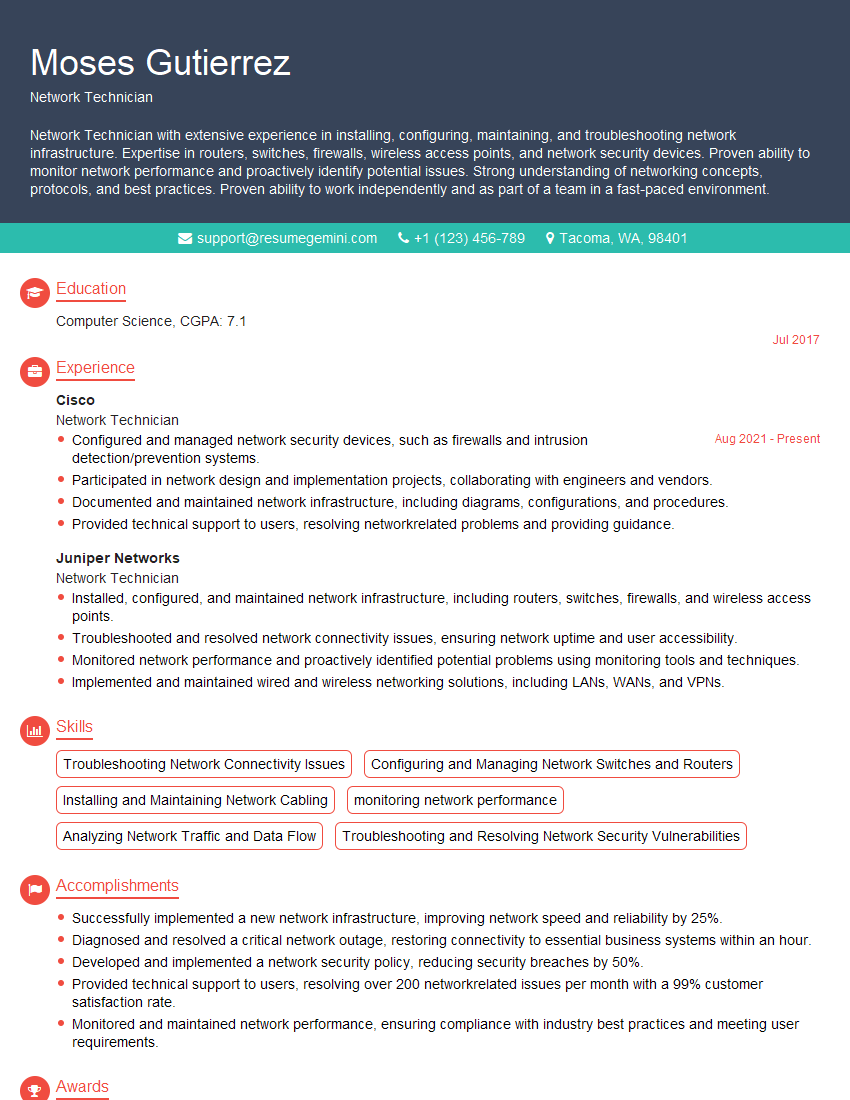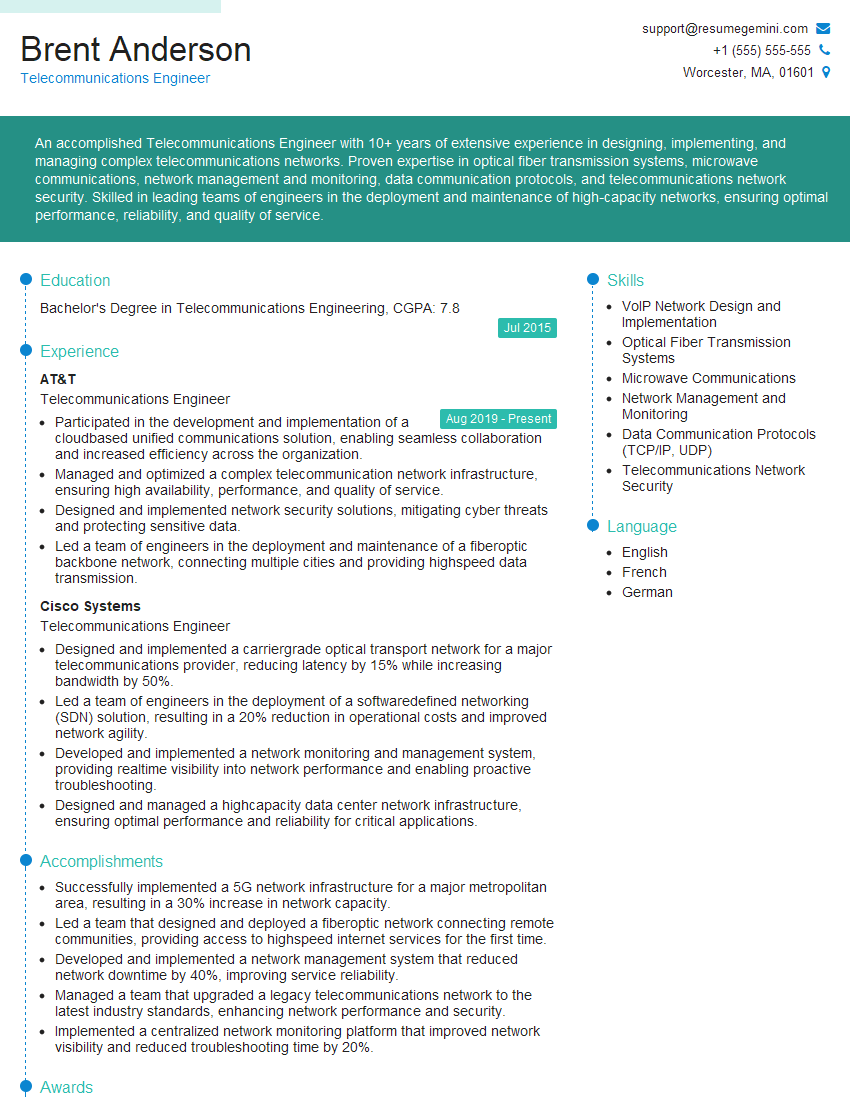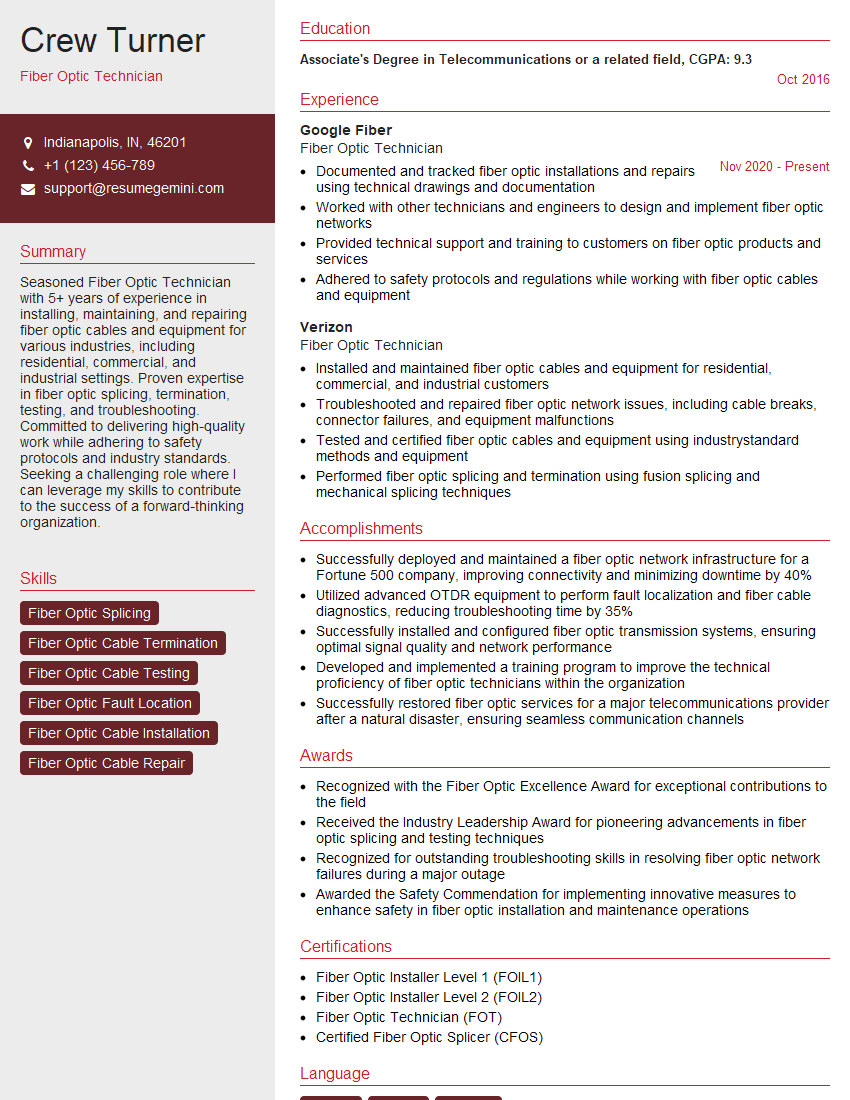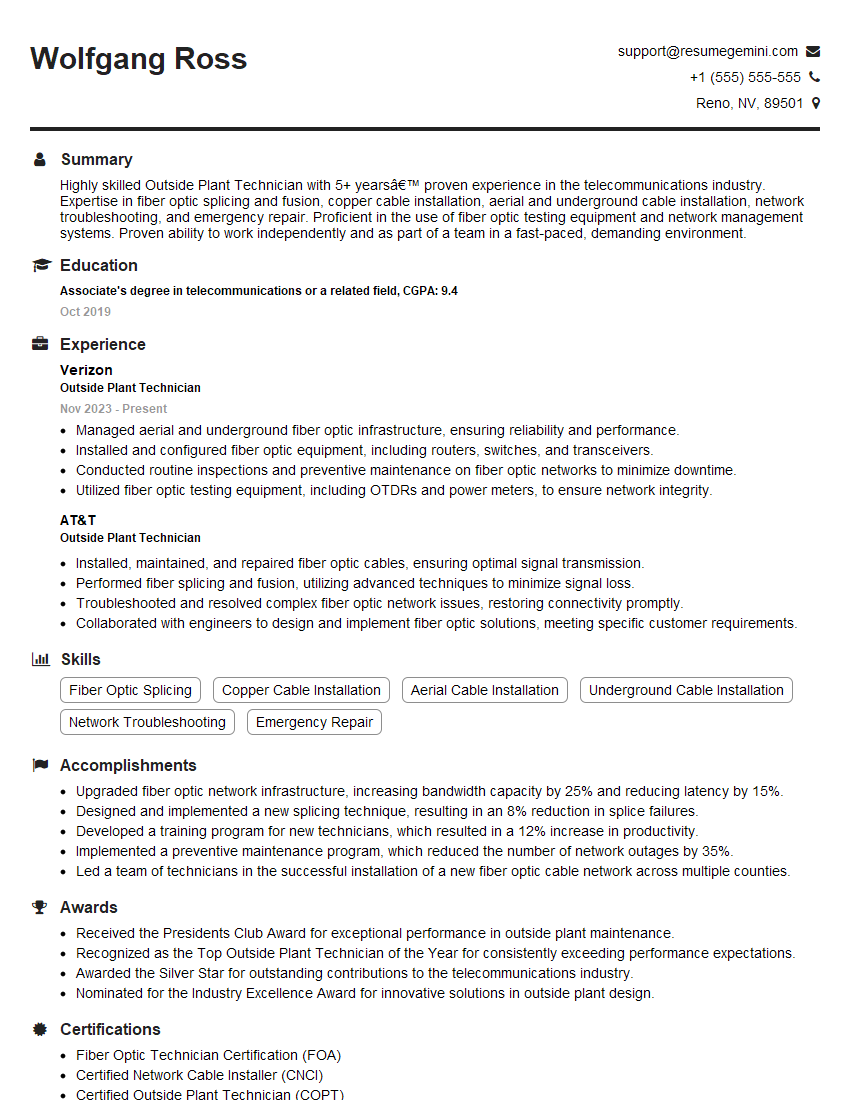The right preparation can turn an interview into an opportunity to showcase your expertise. This guide to Fiber Optic Cable Splicing and Termination interview questions is your ultimate resource, providing key insights and tips to help you ace your responses and stand out as a top candidate.
Questions Asked in Fiber Optic Cable Splicing and Termination Interview
Q 1. Explain the difference between fusion splicing and mechanical splicing.
Fusion splicing and mechanical splicing are two primary methods for joining fiber optic cables. The key difference lies in how the fibers are joined. Fusion splicing uses heat and pressure to melt and fuse the fiber ends together, creating a permanent, incredibly strong, and low-loss connection. Think of it like welding two pieces of metal together. Mechanical splicing, on the other hand, uses a precision-engineered sleeve or connector to align and hold the fiber ends together. This is a more convenient method for some scenarios, but typically offers slightly higher loss and isn’t as strong as a fusion splice. Imagine this like using a clamp to hold two wires together – it works, but it’s not as robust.
- Fusion Splicing: Offers superior performance (lower loss), higher strength, and is more reliable. Requires specialized equipment.
- Mechanical Splicing: Faster and easier, requires less specialized equipment. Offers slightly higher loss and less mechanical strength compared to fusion splicing.
The choice between the two depends on factors such as budget, required performance, and the expertise of the technicians involved. In high-performance networks, where even minimal signal loss is critical, fusion splicing is preferred. For less demanding applications or quick repairs, mechanical splicing might be a more practical choice.
Q 2. Describe the process of preparing fiber optic cable for splicing.
Preparing fiber optic cable for splicing is a crucial step, as even minor imperfections can significantly impact the connection’s performance. The process involves several key steps:
- Cleaning: Thoroughly clean the fiber ends using a specialized fiber optic cleaning kit. This removes any dust, dirt, or grease that can cause high signal attenuation or even prevent the splice from forming properly. Think of it like cleaning the lens of a camera before taking a picture – clarity is key!
- Cutting: Precisely cut the fiber using a cleaver to create a perfectly perpendicular end face. An angled or chipped end will lead to signal loss. We aim for a mirror-like surface.
- Inspection: Inspect the cleaved end under a microscope to ensure the quality of the cut. This is critical because any imperfections, even microscopic ones, will affect the quality of the splice.
- Stripping (if necessary): If necessary, carefully strip away the protective coatings around the fiber, taking care not to damage the fiber itself. Different cable types require different stripping techniques.
Proper preparation is critical for a successful splice, and the best practice is to repeat cleaning and inspection steps to confirm optimal conditions.
Q 3. What safety precautions are essential when working with fiber optic cables?
Safety is paramount when working with fiber optic cables. Although fiber optic cables don’t carry high voltage electricity, there are still potential hazards.
- Eye Safety: The most significant risk is eye damage. A high-powered laser source (used in some testing equipment) can cause serious and permanent eye injury. Always wear appropriate eye protection, including laser safety glasses.
- Sharp Objects: Fiber optic cleavers and other tools used for splicing are sharp. Handle these tools with care to avoid cuts and injuries.
- Working at Heights: Often, fiber optic cables are installed in high places like telephone poles or rooftops. Use proper fall protection equipment and follow safety protocols for working at heights.
- Proper Cable Handling: Avoid excessive bending or kinking of the fiber, as this can damage the fiber.
- Proper Disposal: Broken fiber pieces should be handled carefully and disposed of properly to avoid potential hazards.
Always adhere to established safety procedures and use appropriate personal protective equipment (PPE). It’s crucial to receive training before undertaking any fiber optic work.
Q 4. How do you identify different types of fiber optic connectors?
Fiber optic connectors are identified by their physical characteristics and sometimes by markings. Common types include:
- SC (Subscriber Connector): A push-pull connector with a square shape. Very common in networking.
- LC (Lucent Connector): A smaller, push-pull connector, becoming increasingly popular for its smaller size and density.
- FC (Ferrule Connector): A bayonet-style connector with a screw-type coupling. Usually used in more robust applications.
- ST (Straight Tip): A bayonet-style connector with a push-pull coupling. Less common now, but still encountered in legacy systems.
Connectors are often color-coded, but it is best to visually inspect the connector and refer to the cable documentation for precise identification. Incorrect connector matching can lead to connectivity issues.
Q 5. Explain the importance of proper cable management in fiber optic installations.
Proper cable management is essential for several reasons in fiber optic installations:
- Signal Integrity: Excessive bending or twisting can introduce signal loss and degrade the overall performance of the network. Neat cable management helps maintain signal quality.
- Easy Troubleshooting: Organized cables make it much easier to locate and troubleshoot faults. You don’t want to spend hours untangling a mess of cables when trying to fix a problem.
- Safety: Proper cable management reduces the risk of tripping hazards and accidental damage to the cables. This also enhances worker safety.
- Scalability: Well-managed cabling simplifies future expansion and upgrades to the network. Adding new equipment or cables is easier when the cabling is well-organized.
Techniques like using cable ties, labels, and appropriate cable trays contribute to good cable management. Think of it like organizing a toolbox – everything has its place and is easily accessible.
Q 6. What are the common causes of fiber optic cable damage?
Several factors can lead to damage in fiber optic cables:
- Physical Stress: Bending, crushing, or excessive tension on the cable can cause microscopic fractures in the fiber, leading to signal loss or complete cable failure. Think of repeatedly bending a paperclip – it eventually breaks.
- Rodents: Rodents often chew through cables, causing interruptions to service. This is a common problem.
- Improper Handling: Careless handling during installation or maintenance can lead to cuts, scratches, and other damage to the fiber. This can cause significant attenuation and performance degradation.
- Environmental Factors: Harsh environmental conditions, such as extreme temperatures, moisture, or UV radiation, can also degrade the cable’s performance and its lifespan over time.
- Construction Activities: Digging or construction activities can unintentionally damage buried cables, causing significant disruption to services.
Preventing damage requires careful planning during installation, regular inspections, and use of protective measures such as cable armor or conduit.
Q 7. How do you troubleshoot a fiber optic connection issue?
Troubleshooting a fiber optic connection issue requires a systematic approach:
- Visual Inspection: Begin with a visual inspection of the cables, connectors, and equipment for any obvious signs of damage, such as broken connectors, bent cables, or loose connections. This is often the easiest way to identify the problem.
- Optical Power Meter (OPM): Use an optical power meter to measure the optical power levels at various points in the system. This helps to identify the location of the problem, by pinpointing where the power level drops significantly.
- Optical Time Domain Reflectometer (OTDR): An OTDR allows a more thorough analysis by showing a visual representation of the fiber cable, highlighting any breaks, bends, or other irregularities. It is a more specialized tool used by fiber optic technicians.
- Connector Inspection: Use a microscope to check the quality of the connector end faces. Even a small amount of dirt or damage can significantly affect signal quality.
- Continuity Testing: Some advanced equipment can check the continuity of the cable, to ensure the fiber hasn’t broken somewhere along the cable path.
The specific troubleshooting steps depend on the type of problem and the tools available. A systematic approach, combined with the right tools and expertise, usually leads to a quick identification and resolution of the issue.
Q 8. What tools and equipment are used in fiber optic splicing and termination?
Fiber optic splicing and termination require a specialized toolkit. Think of it like a surgeon’s precision instruments, but for light!
- Fiber Cleaver: This tool creates a precise, perpendicular cleave on the fiber end, crucial for low-loss connections. Imagine trying to connect two pipes – a sloppy cut would lead to leaks; similarly, a bad cleave leads to signal loss.
- Fusion Splicer: This device uses an electric arc to fuse two fiber ends together, creating a virtually seamless connection. It’s like welding two metal rods, but on a microscopic scale.
- Optical Power Meter (OPM): Measures the power level of the optical signal, crucial for determining signal strength after splicing or termination.
- Fiber Optic Connectorization Kit: Includes various tools for preparing the fiber end for connector attachment, such as polishing tools, connector bodies, and epoxy.
- Visual Fault Locator (VFL): A laser pointer that illuminates the fiber path, helping to identify breaks or bends in the cable.
- Stripping Tools: Used to remove the outer jacket and buffer coatings from the fiber without damaging the delicate glass core. It’s like carefully peeling an orange without breaking the segments.
- Microscope: For inspecting the fiber end face for quality and cleanliness before and after splicing or connectorization. This ensures a pristine connection.
- Safety Glasses: Essential eye protection when working with lasers and cleavers.
Q 9. Describe the different types of fiber optic connectors (SC, LC, ST, etc.) and their applications.
Fiber optic connectors are the interface between the fiber cable and equipment. Each type has its own strengths and weaknesses.
- SC (Subscriber Connector): A push-pull connector, relatively large and robust. Often used in older installations and applications where reliability and ease of use are paramount.
- LC (Lucent Connector): A smaller, push-pull connector, preferred for high-density applications due to its smaller size. It’s the more common choice in modern data centers and high-speed networks.
- ST (Straight Tip): A bayonet-style connector, less common now but still found in older systems. Its twisting connection mechanism can be more prone to damage than push-pull types.
- FC (Ferrule Connector): A threaded connector, offering excellent precision and repeatability. Commonly used in more demanding applications requiring higher stability.
The choice of connector depends on factors like the application’s speed, density, and cost considerations. A data center might favor LC connectors for their space-saving design, while a less demanding installation might use SC connectors for simplicity.
Q 10. Explain the concept of optical loss and how it’s measured.
Optical loss is the reduction in the optical signal’s power as it travels through the fiber. Think of it like water flowing through a pipe – some water gets lost due to friction and leaks. This loss is measured in decibels (dB).
It’s measured using an optical power meter (OPM). You insert the OPM at the receiving end of the fiber, and it measures the power level of the light reaching it. By comparing this to the input power, you can calculate the total loss. Loss can originate from various sources: fiber attenuation, connector losses, splice losses, and bending losses. Lower optical loss is always desired for better signal quality and longer transmission distances.
For example, if you transmit 1 mW of optical power and receive 0.5 mW, the loss is 3 dB (calculated using the formula: 10*log10(Pout/Pin), where Pout is the output power and Pin is the input power).
Q 11. What are the different types of fiber optic cables (single-mode, multi-mode)?
Fiber optic cables are classified primarily into single-mode and multi-mode fibers. The difference lies in the core diameter and the number of light paths they can support.
- Single-Mode Fiber: Has a very small core diameter (around 9 µm), allowing only a single light path to propagate. This results in lower attenuation and higher bandwidth, making it ideal for long-distance, high-bandwidth applications like long-haul telecommunications and high-speed data networks.
- Multi-Mode Fiber: Has a larger core diameter (50 µm or 62.5 µm), allowing multiple light paths to travel simultaneously. This leads to higher attenuation and lower bandwidth compared to single-mode fiber but is usually less expensive. Suitable for shorter distances and less demanding applications like local area networks (LANs).
Choosing the correct fiber type is crucial for the success of the project; using multi-mode fiber for a long-haul application would result in significant signal degradation.
Q 12. How do you test fiber optic cable continuity and signal strength?
Testing fiber optic cable continuity and signal strength involves a two-pronged approach. Think of it as checking both the structure (continuity) and the functionality (signal strength) of an electrical circuit, but with light instead of electricity.
- Continuity Testing: This verifies that the fiber is physically connected without breaks. A Visual Fault Locator (VFL) is often used initially to trace the cable and detect any visible breaks. A more sophisticated approach involves the use of an optical time-domain reflectometer (OTDR) for comprehensive mapping of the fiber.
- Signal Strength Testing: This checks the quality and strength of the optical signal traveling through the fiber. An Optical Power Meter (OPM) is used to measure the power level at various points along the fiber, and the results are compared to expectations. A weak signal often indicates problems with connectors, splices, or the fiber itself.
By combining these methods, we obtain a complete assessment of the fiber’s condition and performance.
Q 13. What is OTDR and how is it used in fiber optic testing?
An Optical Time-Domain Reflectometer (OTDR) is a sophisticated instrument used for testing and troubleshooting fiber optic cables. Think of it as an ‘x-ray’ for fiber optics, allowing us to see inside the cable and identify potential problems remotely.
The OTDR works by sending short pulses of light into the fiber. These pulses reflect back from any discontinuities along the fiber such as connectors, splices, or breaks. By measuring the time it takes for the pulses to return, the OTDR can determine the location and severity of these events. It also measures the fiber’s attenuation (loss) along its length. This data provides a detailed map of the fiber optic link, making it invaluable for fault location, network monitoring, and ensuring fiber optic systems meet specifications.
For instance, an OTDR can pinpoint the exact location of a fiber break, helping technicians quickly repair the problem. This significantly reduces downtime and repair costs.
Q 14. Explain the importance of proper cleaving in fiber optic splicing.
Proper cleaving is absolutely critical in fiber optic splicing. A clean, perpendicular cleave is essential for achieving low-loss fusion splices. Think of it like creating a perfect, flat surface on two pieces of wood before gluing them together.
An imperfect cleave, with angled or chipped surfaces, creates air gaps and scattering losses at the splice point. This reduces the light transmission and degrades the signal quality. A good cleave is characterized by a flat, smooth surface, free of chips, cracks, or scratches. A fiber cleaver is used to create this precise cleave and a microscope is used for inspection. The goal is a near perfect 90-degree angle to maximize the efficiency of light transmission at the connection point.
Without a proper cleave, you’ll experience significant signal loss, potentially requiring re-cleaving and re-splicing, leading to increased costs and project delays. It’s a crucial step that directly impacts the overall performance of the fiber optic link.
Q 15. Describe the process of terminating a fiber optic cable with a connector.
Terminating a fiber optic cable with a connector involves precisely preparing the fiber end and securely attaching a connector to ensure minimal signal loss. Think of it like meticulously preparing a wire for a plug – any imperfection leads to poor connection.
The process typically involves:
- Cutting the fiber: Using a cleaver to create a perfectly perpendicular and smooth end face. A slightly angled or chipped end will cause significant signal loss.
- Cleaning the fiber: Removing any dust or debris from the fiber end using appropriate cleaning supplies. Even a tiny particle can disrupt the light signal.
- Preparing the connector: This might involve polishing the connector ferrule (the cylindrical part that holds the fiber) if necessary, to ensure optimal contact.
- Inserting the fiber: Carefully inserting the prepared fiber end into the connector ferrule, ensuring it’s correctly seated and aligned.
- Curing (if applicable): Some connectors require curing with UV light or heat to set the adhesive and firmly secure the fiber in place.
- Testing: Once terminated, the connection should be tested with an optical power meter to ensure low insertion loss (minimal signal loss).
Different connector types (e.g., SC, LC, ST) have variations in this process, but the core principles remain the same: precise fiber preparation and secure connection.
Career Expert Tips:
- Ace those interviews! Prepare effectively by reviewing the Top 50 Most Common Interview Questions on ResumeGemini.
- Navigate your job search with confidence! Explore a wide range of Career Tips on ResumeGemini. Learn about common challenges and recommendations to overcome them.
- Craft the perfect resume! Master the Art of Resume Writing with ResumeGemini’s guide. Showcase your unique qualifications and achievements effectively.
- Don’t miss out on holiday savings! Build your dream resume with ResumeGemini’s ATS optimized templates.
Q 16. How do you ensure the proper alignment of fibers during fusion splicing?
Accurate fiber alignment is critical during fusion splicing to minimize signal loss. Imagine trying to perfectly connect two tiny pipes carrying water – any misalignment reduces the water flow. Fusion splicers use several mechanisms to ensure this precision:
- Clamping Mechanism: The splicer uses a precisely engineered clamping mechanism to hold the two fiber ends in perfect alignment. This is typically aided by a high-resolution microscopic view.
- Active Alignment: Advanced splicers use active alignment systems, which use sensors and actuators to actively adjust the fiber position until perfect alignment is achieved. This ensures the fiber cores are centered on each other, maximizing light transmission.
- Visual Inspection: Before splicing, the fiber ends are carefully inspected through a microscope to verify their cleanliness and quality. A visual check ensures the presence of any damage that might hinder alignment.
- Splice Loss Measurement: After splicing, the splicer typically measures the splice loss (the reduction in optical power due to the splice). A low splice loss indicates accurate alignment.
The goal is to achieve a splice loss within the acceptable range – typically less than 0.1 dB. Higher losses point to misalignment or other issues requiring troubleshooting.
Q 17. What are the different types of fiber optic splicers (fusion, mechanical)?
Fiber optic splicers come in two main types: fusion and mechanical.
- Fusion Splicers: These splicers use an electric arc to melt and fuse the ends of two fibers together, creating a permanent, strong, and low-loss splice. They are precise and offer excellent long-term performance. Imagine it like welding two metal rods together—creating a seamless and strong joint. They generally provide lower loss than mechanical splices but require more specialized equipment.
- Mechanical Splicers: These use a precisely engineered sleeve or connector to physically join the two fiber ends. They are generally simpler and quicker to use than fusion splicers, requiring less specialized training and equipment. However, mechanical splices tend to have higher insertion loss and may be less durable.
Choosing the right type of splicer depends on factors like the application, cost considerations, required performance, and the skill level of the personnel. Fusion splicers are preferred for high-performance applications, while mechanical splicers are better suited for temporary connections or situations where speed is prioritized.
Q 18. How do you interpret OTDR test results?
An Optical Time-Domain Reflectometer (OTDR) test provides a visual representation of the optical fiber’s characteristics along its length. Think of it as an x-ray of your fiber optic cable. It reveals information like:
- Fiber Length: The total length of the fiber under test.
- Splice Loss: Attenuation (signal loss) at each splice point.
- Connector Loss: Attenuation at each connector.
- Fiber Attenuation: Signal loss due to the inherent properties of the fiber itself.
- Events: Significant changes in signal strength, indicating potential problems (e.g., breaks, bends, or connector issues).
The OTDR results are displayed as a graph showing signal strength versus distance. A sudden drop in the signal strength indicates an event. By analyzing the graph, technicians can identify the location and nature of problems, facilitating targeted repair or maintenance.
For example, a consistent gradual decrease in signal strength might indicate an issue with the fiber quality itself, while a sharp, abrupt drop suggests a break in the fiber.
Q 19. What are the common causes of high optical loss in a fiber optic link?
High optical loss in a fiber optic link can stem from various sources. It’s like having leaks in a water pipe – you need to identify the source(s) to fix the problem.
- Poorly Cleaved Fiber Ends: A chipped or angled fiber end significantly increases loss.
- Contamination: Dust, dirt, or other particles on the fiber ends.
- Misaligned Connectors: Poor alignment between connectors causes significant loss.
- High Splice Loss: Poorly executed fusion or mechanical splices.
- Microbends: Small bends in the fiber that disrupt the light signal.
- Macrobends: Large bends that cause significant loss.
- Fiber Damage: Physical damage to the fiber (e.g., cuts, cracks).
- Improper Cable Handling: Rough handling can introduce microbends or damage.
Troubleshooting involves systematically checking these potential causes, starting with simple checks like inspecting connector terminations and then using tools like OTDR to identify more subtle issues.
Q 20. Describe the different types of fiber optic cable jackets and their applications.
Fiber optic cable jackets serve as protection for the delicate fibers inside. Different jacket types offer different levels of protection and are suited to various applications.
- High-Density Polyethylene (HDPE): A common choice for its good balance of strength, flexibility, and cost-effectiveness. Often used in indoor and outdoor environments where moderate protection is needed.
- Low-Smoke Zero-Halogen (LSZH): Designed for applications where fire safety is paramount. They produce less smoke and toxic fumes in case of a fire.
- Acrylonitrile Butadiene Styrene (ABS): A rigid, durable jacket used in high-impact applications or where additional mechanical protection is required.
- Polyvinyl Chloride (PVC): A versatile jacket material that offers decent protection but can be susceptible to damage in extreme conditions.
- Aramid Yarn: Often included as an extra layer of protection for increased tensile strength. It’s frequently used in applications where the cable is exposed to stress or pulling forces.
The choice of jacket material depends on the environmental conditions, the required level of protection, and safety regulations. For example, LSZH jackets would be favored in a hospital or subway, where minimizing smoke and toxic gases during a fire is critical.
Q 21. How do you deal with microbends in fiber optic cables?
Microbends are tiny bends in the fiber optic cable that significantly affect signal transmission. Imagine tiny kinks in a water pipe – they disrupt the flow of water. These bends scatter light and increase attenuation, leading to higher loss and reduced signal quality.
Dealing with microbends involves careful cable handling and installation practices:
- Proper Cable Routing: Avoiding sharp bends or kinks during installation. Use cable trays, conduits, and proper bending radii to minimize stress on the cable.
- Careful Cable Termination: Avoid excessive tension during termination to prevent microbends at the connector.
- Using Appropriate Cable Management Techniques: Employing cable ties, straps, or other methods to secure the cable without excessive pressure.
- Identifying and Fixing Existing Microbends: During testing with an OTDR, if microbends are identified, the affected cable section may need replacement or rerouting.
- Buffer Tubes and Cable Construction: Using cables with appropriate buffer tubes and structural components can help minimize the impact of microbends.
Preventing microbends is crucial for maintaining a reliable fiber optic link. Careful planning and execution during installation and maintenance are key to avoiding these issues.
Q 22. What are the safety regulations for handling fiber optic cables?
Safety when handling fiber optic cables is paramount. The primary concern is eye safety. Broken fibers can release microscopic shards of glass that can cause serious eye injuries. Always wear appropriate eye protection, such as safety glasses or goggles, designed specifically for fiber optic work. These glasses often have side shields for added protection.
Beyond eye protection, consider these precautions:
- Never point a fiber end towards your face or anyone else’s. Even seemingly harmless ends can be dangerous.
- Use caution when handling fiber optic connectors. Always ensure connectors are properly cleaned and capped when not in use to prevent damage and contamination.
- Work in a clean environment. Dust and debris can affect connection quality and introduce further safety hazards.
- Use appropriate tools. Improper tools increase the risk of damage to the fiber or injury to yourself.
- Follow all manufacturer’s instructions for the equipment you are using. Each manufacturer has specific guidelines.
- Ground yourself to prevent static discharge, which can damage sensitive optical components. This is especially important in dry climates.
In a professional setting, adhering to these safety protocols is mandatory. It protects both the worker and the integrity of the fiber optic network.
Q 23. What is the difference between attenuation and scattering loss in optical fibers?
Attenuation and scattering loss are both forms of signal degradation in optical fibers, but they stem from different physical phenomena. Imagine sending light down a long straw; both processes would weaken the light.
Attenuation is the gradual weakening of the optical signal as it travels down the fiber. It’s primarily caused by absorption of the light energy by the fiber material itself and the imperfections in the material. Think of it as the light being slowly absorbed by the straw’s material. Different wavelengths of light are absorbed to different degrees. Several factors influence attenuation, including the fiber’s material composition, its impurities, and its length. A longer fiber will result in greater attenuation.
Scattering loss, on the other hand, involves the light bouncing off imperfections or impurities within the fiber’s core. Instead of being absorbed, the light is redirected away from its intended path. It’s like light scattering as it passes through slightly cloudy water in the straw. This scattered light doesn’t reach the destination, leading to a weaker signal. Scattering can be caused by micro-bends in the fiber or by impurities in the glass. Rayleigh scattering, a form of scattering caused by microscopic fluctuations in the fiber’s density, is particularly significant in shorter wavelengths.
Both attenuation and scattering loss contribute to the overall signal loss in a fiber optic cable and limit the transmission distance. Engineers account for this loss when designing long-haul fiber optic networks.
Q 24. Explain the importance of using a cleaning process for fiber optic connectors.
Cleaning fiber optic connectors is crucial for maintaining signal quality and preventing connection problems. Even microscopic amounts of dust, oil, or fingerprints can significantly impact the performance of a fiber optic link. Think of it like trying to connect two straws – any debris between the ends would block the flow of air.
Contamination leads to several issues including:
- Increased attenuation and signal loss: This reduces the distance the signal can travel.
- High return loss (reflection): The signal bounces back, interfering with the transmitted signal.
- Connection failures: Incomplete connections can cause intermittent outages.
- Damage to the connector itself: Forceful attempts to connect contaminated connectors may scratch the end face, creating further problems.
A proper cleaning procedure typically involves using a specialized cleaning kit with lint-free wipes and cleaning solution designed for optical fibers, followed by inspection with a microscope, if possible. Following manufacturer’s instructions for cleaning is very important.
Q 25. How do you identify and fix a macrobend in a fiber optic cable?
A macrobend is a large-radius bend in a fiber optic cable, significantly larger than the fiber’s diameter, causing increased attenuation and signal loss. It’s like sharply bending the straw, which restricts the flow of air.
Identification: Macrobends are usually visually identifiable as a sharp bend in the cable. Optical Time Domain Reflectometry (OTDR) can also pinpoint the location and severity of the bend by detecting a change in the signal reflection.
Fixing: The solution is to carefully straighten the bend, restoring the cable to its original shape as much as possible. You must avoid applying excessive force or damaging the fiber during this process. In some cases, if the bend is severe or the cable is damaged, the affected section might need to be replaced entirely.
Q 26. How would you handle a situation where you encountered unexpected fiber damage during installation?
Discovering unexpected fiber damage during installation is a serious situation requiring careful handling. My approach would involve several steps:
- Assess the damage: First, determine the extent of the damage – is it a small scratch, a crack, or a complete break? Document the issue using photos and notes.
- Safety First: Ensure the area is safe and wear appropriate safety gear.
- Isolate the damaged section: If possible, temporarily disconnect the damaged section from the rest of the network to prevent further problems.
- Determine the cause: Try to understand *why* the damage occurred. Was it caused by improper handling, sharp objects, or environmental factors? This helps prevent recurrence.
- Repair or Replace: Depending on the severity and location of the damage, I would either attempt repair (e.g., fusion splicing for a clean break) or replace the entire cable section. Choosing the right technique would depend on my training, the resources available, and the type of cable.
- Test thoroughly: Once repaired or replaced, perform thorough testing to ensure the integrity of the network and that signal quality has been restored. Use an OTDR to check for any remaining issues.
- Document the situation and resolution: Maintain detailed records of the repair or replacement, including the type of damage, steps taken, and testing results.
Unexpected damage highlights the importance of thorough planning, careful installation techniques, and regular maintenance.
Q 27. What is your experience with different types of fiber optic cable connectors and their associated testing equipment?
I have extensive experience with various fiber optic connectors, including SC, FC, LC, ST, and MPO. Each connector type has specific advantages and disadvantages regarding ease of use, density, and cost. For example, LC connectors are popular in high-density applications due to their small size, while MPO connectors are used for high-bandwidth applications requiring multiple fibers in a single connector.
My experience with testing equipment includes the use of OTDRs (Optical Time Domain Reflectometers) for identifying faults and measuring attenuation along fiber links, power meters for assessing signal strength, and visual fault locators (VFLs) for quickly identifying breaks or bends in fibers. I am proficient in using these tools to test the performance of various fiber optic connectors and systems. I’m also familiar with optical spectrum analyzers for more in-depth analysis and characterization.
Through my experience, I’ve developed a keen understanding of the importance of proper connector cleaning and termination techniques to ensure optimal performance and avoid costly downtime.
Key Topics to Learn for Fiber Optic Cable Splicing and Termination Interview
- Fiber Optic Cable Types and Properties: Understanding different fiber types (single-mode, multi-mode), their characteristics (attenuation, dispersion), and applications.
- Splicing Techniques: Mastering fusion splicing, mechanical splicing, and their respective advantages and disadvantages. Practical experience with different splicing equipment is crucial.
- Termination Methods: Proficiency in various termination techniques, including the use of connectors (SC, FC, LC, ST) and understanding the importance of proper cleaning and polishing.
- Optical Loss Measurement: Familiarizing yourself with OTDR testing, its principles, and interpretation of results to identify faults and losses within the fiber optic network.
- Safety Procedures and Precautions: Demonstrating a strong understanding of safety protocols when handling fiber optic cables and equipment, including laser safety.
- Troubleshooting and Problem Solving: Ability to diagnose and resolve common issues encountered during splicing and termination, such as high optical loss, connector problems, and fiber breaks. Be prepared to discuss your approach to troubleshooting.
- Network Topologies and Design: Understanding different fiber optic network architectures (e.g., star, ring, bus) and their implications for splicing and termination practices.
- Industry Standards and Codes: Familiarity with relevant industry standards and best practices for fiber optic cabling.
Next Steps
Mastering Fiber Optic Cable Splicing and Termination opens doors to exciting career opportunities in telecommunications, data centers, and various other high-growth industries. A strong understanding of these skills significantly enhances your value to potential employers. To maximize your job prospects, creating a professional, ATS-friendly resume is essential. ResumeGemini is a trusted resource that can help you build a compelling resume that highlights your skills and experience effectively. ResumeGemini provides examples of resumes tailored to Fiber Optic Cable Splicing and Termination to guide you in crafting your own. Invest time in building a strong resume – it’s your first impression with potential employers.
Explore more articles
Users Rating of Our Blogs
Share Your Experience
We value your feedback! Please rate our content and share your thoughts (optional).
What Readers Say About Our Blog
Hi, I’m Jay, we have a few potential clients that are interested in your services, thought you might be a good fit. I’d love to talk about the details, when do you have time to talk?
Best,
Jay
Founder | CEO







